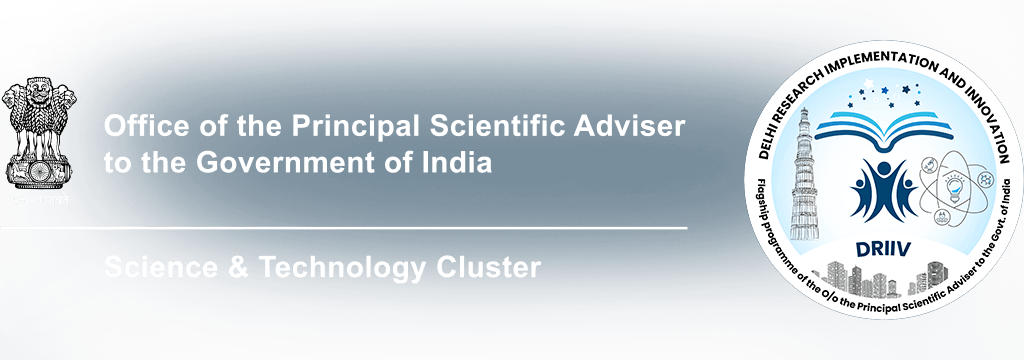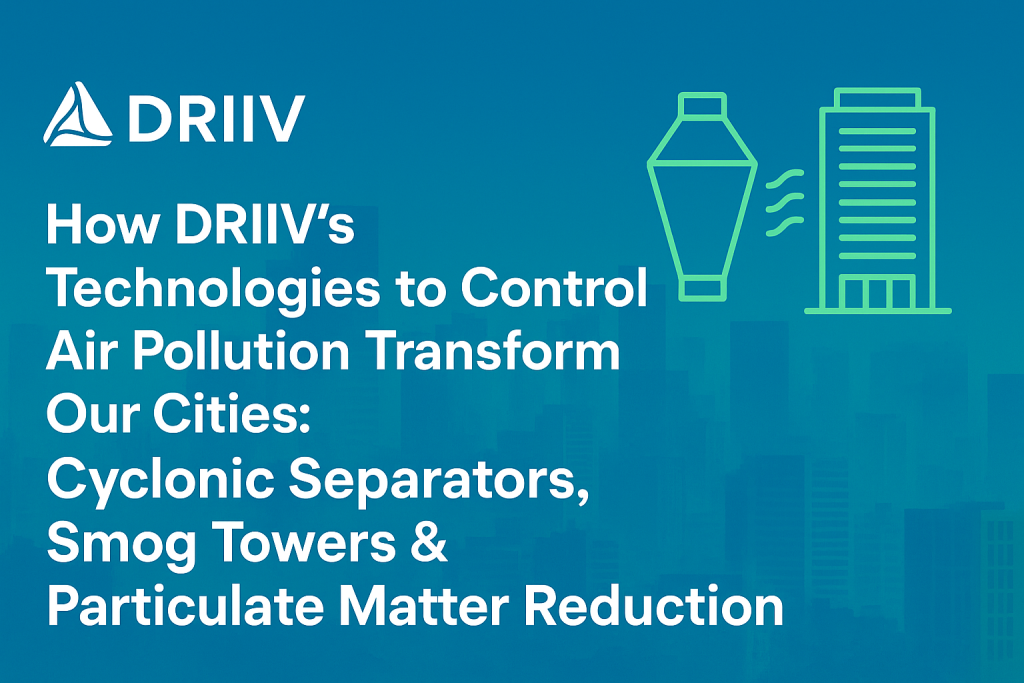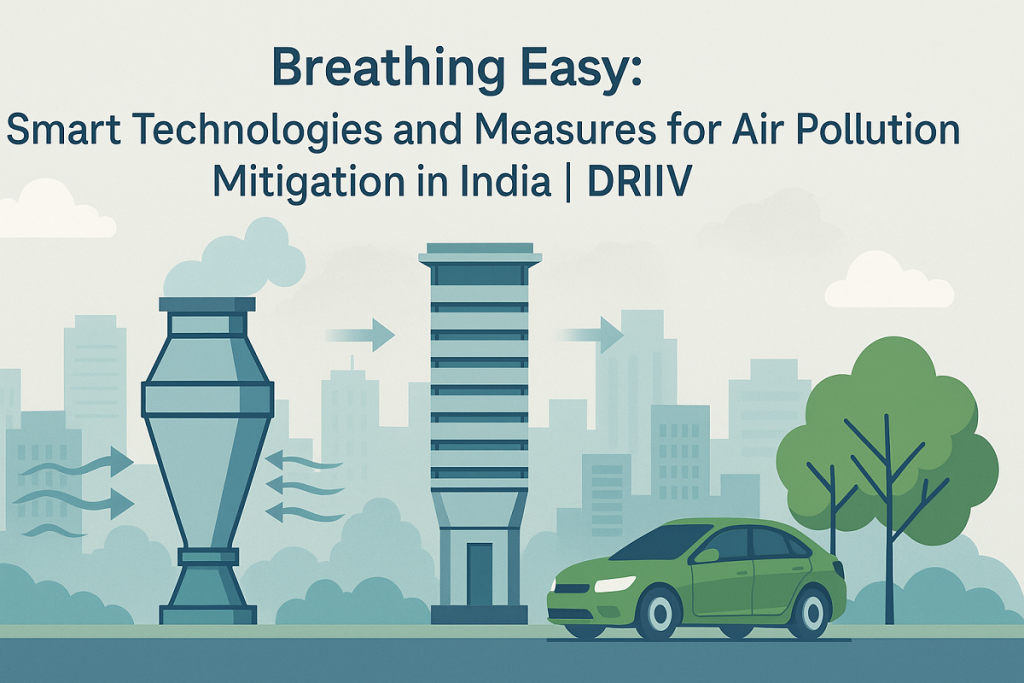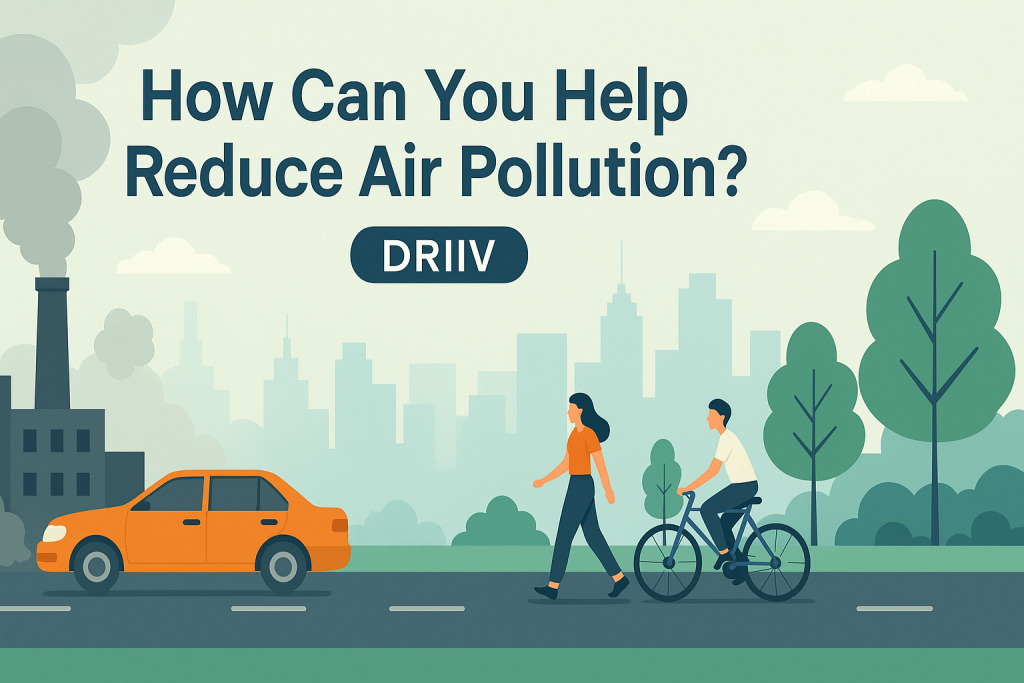Introduction
Air pollution is one of the most pressing challenges of our time. With health warnings rising and cities choked by smog, it’s clear—we need smart solutions. At DRIIV, we specialize in technologies to control air pollution, providing scalable, efficient, and innovative systems. In this post, we’ll explore how Cyclonic Separators, Smog Towers, and Particulate Matter Reduction strategies are changing the game. You’ll also learn why these technologies are trending and what they mean for public health and sustainability.
Why Air Pollution Control Matters
Health Risks: Respiratory diseases, heart problems, and even cognitive decline are linked to polluted air.
Economic Costs: Lost productivity, increased healthcare spending, and environmental cleanup top billions annually.
Global Impact: Air pollution crosses borders. Affected cities worldwide demand strategic, scalable solutions.
Technologies to Control Air Pollution Used by DRIIV
1. Cyclonic Separators
Cyclonic Separators are mechanical devices that remove large dust and pollutant particles from industrial and urban emissions.
How they work: Polluted air enters a cyclone chamber and spins quickly. Centrifugal force pushes particles outward where they settle and can be removed.
Benefits:
- No filter media = low maintenance
- Effective for coarse particles
- Scalable in sizes from small units to large industrial systems
- Applications: Cement plants, sawmills, and waste-to-energy facilities
2. Smog Towers
Smog Towers—also called “air purifying towers”—are large vertical structures installed in high-traffic or industrial zones.
How they work: Large fans draw in polluted air, which passes through filters (HEPA, activated carbon) that trap dust (PM10, PM2.5) and chemical toxins. Clean air is released at the top.
Benefits:
- Visibly reduces local pollution
- Improves quality in “pollution hot spots”
- Educational impact: visible effort shows communities that action is being taken
- Notable implementations: Delhi Metropolitan India, Beijing China, Mexico City
3. Particulate Matter Reduction
Particulate Matter Reduction refers to strategies and tech focused on lowering PM10 and PM2.5 in urban and industrial zones.
Combined approaches:
- Cyclonic Separators for industrial stacks
- Electrostatic Precipitators (ESPs) for fine PM
- Smog Towers in street-level pollution zones
- Real-time monitoring using air sensors & IoT
Benefits of PM reduction:
- Fewer breathing problems
- Lower rates of asthma and lung cancer
- Cleaner visibility and fewer odor issues
Why DRIIV’s Solutions Stand Out
Integrated Systems
DRIIV blends industrial-grade Cyclonic Separators with consumer-level Smog Towers and smart sensors. Your facility and community get fully scalable air-quality solutions.
Modular Installation
- Easily scaled up from single-unit to city-wide deployments
- Compatible with existing infrastructure or new construction
Data Driven
- IoT-enabled sensors provide real-time air quality analytics
- Maintenance schedules based on data—not guesswork
- Smart dashboards for operators and city officials
Cost-Effective ROI
- Lower energy/waste operating costs
- Savings from reduced fines, healthcare costs, and carbon fees
- Cleaner air leads to happier, healthier communities
Trending Search Terms & How DRIIV Addresses Them
Here are common keywords people are searching for right now—and how DRIIV’s blog answers them:
“best air pollution control technologies”
→ We highlight Cyclonic Separators and Smog Towers as top choices.
“PM2.5 solutions for city pollution”
→ Our particulate-matter reduction tech focuses on PM2.5 with proven effectiveness.
“industrial dust collector systems”
→ Cyclonic Separators (dust collectors) are detailed for industrial users.
“outdoor air purifier tower”
→ Smog Towers fit this trend perfectly: big, visible, outdoor purifiers.
“reduce particulate matter in urban air”
→ We offer a blended strategy using real tech (cyclones, filters, sensors).
Including these phrases naturally boosts SEO visibility and ensures users searching for these terms find DRIIV’s offerings.
Real-World Usage & Impact
Delhi, India: Smog Tower pilot projects near highways improved local PM2.5 by up to 30% in some zones.
Industrial Zone, Gujarat: Cyclonic Separators helped one plant cut visible dust emissions by 70% and reduced stack cleaning costs significantly.
Global Cities: Beijing and Mexico City have deployed outdoor Smog Towers creating cleaner breathing zones near schools and busy plazas.
These use cases provide compelling proof—DRIIV’s technologies to control air pollution deliver measurable results in health, visibility, and compliance.
Implementation Guide with DRIIV
- Site Evaluation
Air quality baseline measured using sensors and government data.
- Customized Design
Decide on Cyclonic Separators, Smog Towers, or combined solutions.
- Pilot Testing
Small-scale deployment in high-pollution hotspots.
- Scale-Up
Roll out solutions across larger zones or multiple facilities based on initial results.
- Ongoing Monitoring & Maintenance
IoT dashboards and alerts keep systems running at peak performance.
Benefits at a Glance
Aspect DRIIV’s Solution
Health Impacts Cuts PM2.5 and PM10—reduces asthma, COPD, heart illness
Compliance & Fines Meets stricter emission rules—avoids penalties
Costs & Efficiency Low-maintenance cyclones + modular deployment = lower total costs
Visibility & Awareness Smog Towers show public action and clean air in real time
Data & Insights IoT sensors → smart maintenance + continuous improvement
FAQs
Q1. What are Cyclonic Separators and why use them?
A: These are mechanical dust collectors using rotating airflow to separate large particles from air. They need no filter media, are ultra-low maintenance, and work great with heavy dust loads.
Q2. Do Smog Towers really make a difference?
A: Yes—studies show they can reduce PM levels by 20–30% in their immediate vicinity, making them ideal for schools, bus stops, and city plazas.
Q3. How does Particulate Matter Reduction differ from general air purification?
A: It targets PM2.5 and PM10 specifically. This is vital since fine particles penetrate deep into lungs and bloodstream. DRIIV’s tech suite is designed for this exact goal.
Q4. Are these solutions expensive?
A: While there is upfront cost, the long-term ROI is strong. Savings come from lower health costs, penalty avoidance, and energy-efficient design.
Q5. Can DRIIV help my city or facility even if it’s small?
A: Absolutely! DRIIV’s systems are modular and scalable. We tailor plans for small-town public works up to major industrial complexes.
Conclusion
Air pollution demands bold solutions—and DRIIV’s technologies to control air pollution deliver. Our Cyclonic Separators, Smog Towers, and Particulate Matter Reduction systems work together to clean air, protect health, and help communities and industries thrive.
If your city or company is seeking effective air-quality solutions, contact DRIIV today. Let’s build cleaner, healthier futures together.
Keyword Recap (for SEO & readability)
- technologies to control air pollution
- Cyclonic Separators
- Smog Towers
- Particulate Matter Reduction
- best air pollution control technologies
- PM2.5 solutions
- industrial dust collector systems
- outdoor air purifier tower
Call to Action
Contact DRIIV now to schedule an air-quality assessment and explore how our solutions can help your facility, community, or city tackle air pollution head-on. Don’t breathe dirty air—let DRIIV clean it!




